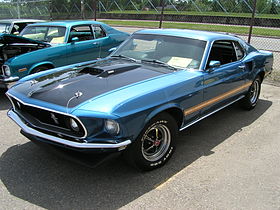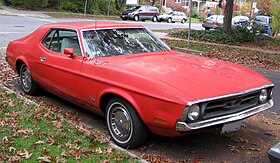Ford Mustang (first generation)
| Mustang first generation | |
|---|---|

1965 Ford Mustang
|
|
| Overview | |
| Manufacturer | Ford |
| Production | March 1964–June 1973 |
| Model years | 1965–1973 |
| Assembly |
Dearborn, Michigan San Jose, California Metuchen, New Jersey Valencia, Venezuela Mexico City, Mexico |
| Body and chassis | |
| Class | Pony car |
| Body style | 2-door hardtop 2-door fastback/sportsroof 2-door convertible |
| Layout | FR layout |
| Related |
Ford Falcon Mercury Cougar Mercury Comet Ford Ranchero |
| Chronology | |
| Successor | Ford Mustang II |
| Mustang 1964–1966 | |
|---|---|

1966 Ford Mustang
|
|
| Overview | |
| Production | March 1964–July 1966 |
| Assembly |
Dearborn, Michigan San Jose, California Metuchen, New Jersey Valencia, Venezuela Mexico City, Mexico |
| Designer | Joe Oros David Ash Gale Haldeman Charlie Phaneuf (fastback) Philip T. Clark (Mustang I concept) John Najjar (Mustang I concept) |
| Body and chassis | |
| Body style | 2-door hardtop 2-door fastback 2-door convertible |
| Related | 1965–1966 Shelby Mustang G.T.350 |
| Powertrain | |
| Engine | 170 cu in (2.8 L) Thriftpower I6 200 cu in (3.3 L) Thriftpower I6 260 cu in (4.3 L) Windsor V8 289 cu in (4.7 L) Windsor V8 289 cu in (4.7 L) Windsor HiPo V8 |
| Transmission | 3-speed manual 4-speed manual 3-speed automatic |
| Dimensions | |
| Wheelbase | 108 in (2,743 mm) |
| Length | 181.6 in (4,613 mm) |
| Width | 68.2 in (1,732 mm) |
| Height | 51.2 in (1,300 mm) |
| Curb weight | 2,445 lb (1,109 kg) (base) |
| Mustang 1967–1968 | |
|---|---|

1968 Ford Mustang
|
|
| Overview | |
| Production | August 1966–August 1968 |
| Assembly |
Dearborn, Michigan San Jose, California Metuchen, New Jersey Valencia, Venezuela Mexico City, Mexico Lima, Peru |
| Designer | Ross Humphries (1965) |
| Body and chassis | |
| Body style | 2-door hardtop 2-door fastback 2-door convertible |
| Powertrain | |
| Engine | 200 cu in (3.3 L) Thriftpower I6 260 cu in (4.3 L) Windsor V8 289 cu in (4.7 L) Windsor V8 289 cu in (4.7 L) Windsor HiPo V8 302 cu in (4.9 L) Windsor V8 390 cu in (6.4 L) FE V8 427 cu in (7.0 L) FE HiPo* V8 428 cu in (7.0 L) Cobra Jet V8 |
| Transmission | 3-speed manual 4-speed manual 3-speed automatic |
| Dimensions | |
| Wheelbase | 108 in (2,743 mm) |
| Length | 183.6 in (4,663 mm) |
| Width | 70.9 in (1,801 mm) |
| Height | 51.6 in (1,311 mm) |
| Curb weight | 2,758 lb (1,251 kg) (base) |
| Mustang 1969–1970 | |
|---|---|

1969 Ford Mustang Mach 1
|
|
| Overview | |
| Production | July 1968–June 1970 |
| Assembly |
Dearborn, Michigan Milpitas, California Metuchen, New Jersey Valencia, Venezuela Mexico City, Mexico |
| Designer | Gale Halderman (1966) |
| Body and chassis | |
| Body style | 2-door hardtop 2-door fastback 2-door convertible |
| Powertrain | |
| Engine | 200 cu in (3.3 L) Thriftpower I6 250 cu in (4.1 L) Thriftpower I6 302 cu in (4.9 L) Windsor V8 302 cu in (4.9 L) Boss V8 351 cu in (5.8 L) Windsor V8 351 cu in (5.8 L) Cleveland V8 390 cu in (6.4 L) FE V8 428 cu in (7.0 L) Cobra Jet & Super Cobra Jet V8 429 cu in (7.0 L) Boss V8 |
| Transmission | 3-speed manual 4-speed manual 3-speed automatic |
| Dimensions | |
| Wheelbase | 108 in (2,743 mm) |
| Length | 187.5 in (4,762 mm) |
| Width | 71.7 in (1,821 mm) |
| Height | 50.5 in (1,283 mm) |
| Curb weight | 3,122 lb (1,416 kg) (base) |
| Mustang 1971–1973 | |
|---|---|

1972 Ford Mustang
|
|
| Overview | |
| Production | 1970–1973 |
| Assembly |
Dearborn, Michigan San Jose, California Metuchen, New Jersey Valencia, Venezuela Mexico City, Mexico |
| Body and chassis | |
| Body style | 2-door hardtop 2-door sportsroof 2-door convertible |
| Powertrain | |
| Engine | 250 cu in (4.1 L) Thriftpower I6 302 cu in (4.9 L) Windsor V8 351 cu in (5.8 L) Cleveland V8 429 cu in (7.0 L) Cobra Jet & Super Cobra Jet V8 |
| Transmission | 3-speed manual 4-speed manual 3-speed automatic |
| Dimensions | |
| Wheelbase | 109 in (2,769 mm) |
| Length | 189.5 in (4,813 mm) |
| Width | 74.1 in (1,882 mm) |
| Height | 50.1 in (1,273 mm) |
| Curb weight | 3,560 lb (1,615 kg) |
The first-generation Ford Mustang was manufactured by Ford from March 1964 until 1973. The introduction of the Mustang created a new class of automobile known as the pony car. The Mustang’s styling, with its long hood and short deck, proved wildly popular and inspired a host of imitators.
It was initially introduced as a hardtop and convertible with the fastback version put on sale in August 1964. At the time of its introduction, the Mustang, sharing its underpinnings with the Falcon, was slotted into a compact car segment.
With each revision, the Mustang saw an increase in overall dimensions and in engine power. The 1971 model saw a drastic redesign to its predecessors. After an initial surge, sales were steadily declining, as Ford began working on a new generation Mustang. With the onset of the 1973 oil crisis, Ford was prepared, having already designed the smaller Mustang II for the 1974 model year. This new car had no common components with preceding models.
As Lee Iacocca's assistant general manager and chief engineer, Donald N. Frey was the head engineer for the Mustang project — supervising the development of the Mustang in a record 18 months from September 1962 to March 1964. — while Iacocca himself championed the project as Ford Division general manager.
Drawing on inspiration from the mid-engined Ford Mustang I concept vehicle, Lee Iacocca ordered development of a new "small car" to vice-president of design at Ford, Eugene Bordinat. Bordinat tasked Ford's three design studios (Ford, Lincoln-Mercury, and Advanced Design) to create proposals for the new vehicle.
The design teams had been given five goals for the design of the Mustang: It would seat four, have bucket seats and a floor mounted shifter, weigh no more than 2,500 pounds (1,100 kg) and be no more than 180 inches (4,572 mm) in length, sell for less than $2,500, and have multiple power, comfort, and luxury options.
The Lincoln–Mercury design studio ultimately produced the winning design in the intramural contest, under Project Design Chief Joe Oros and his team of L. David Ash, Gale Halderman, and John Foster.
...
Wikipedia
